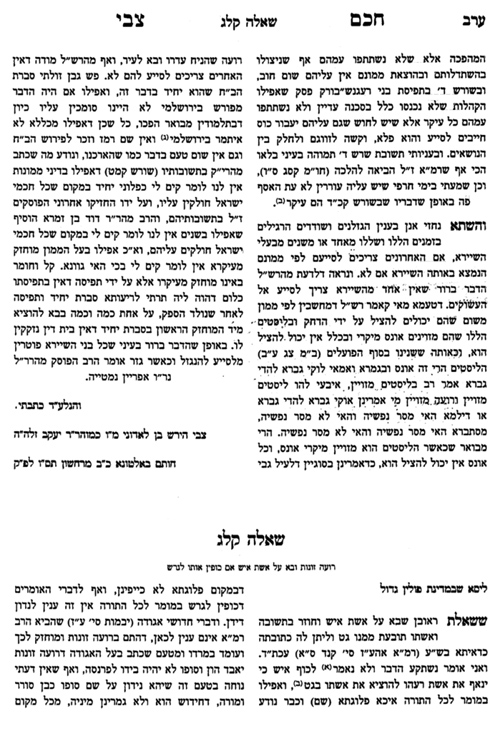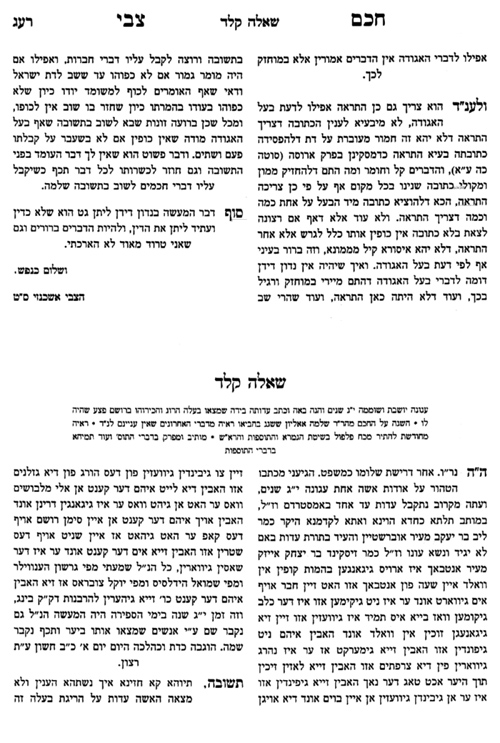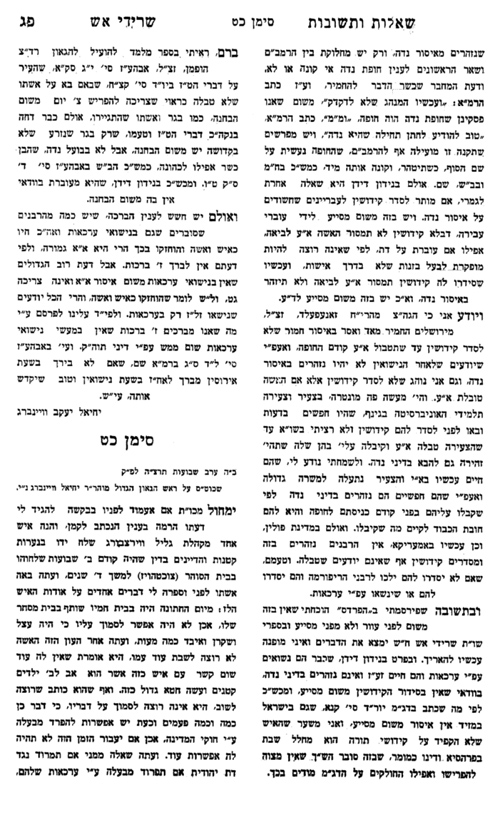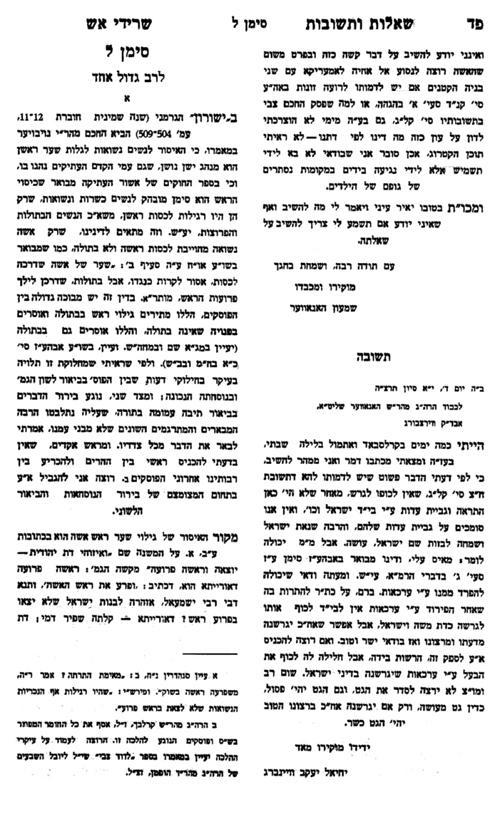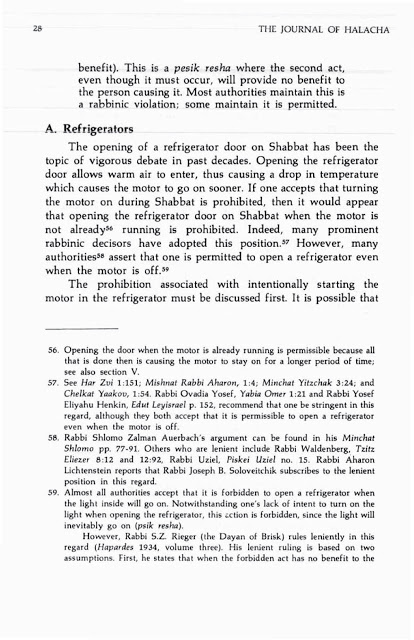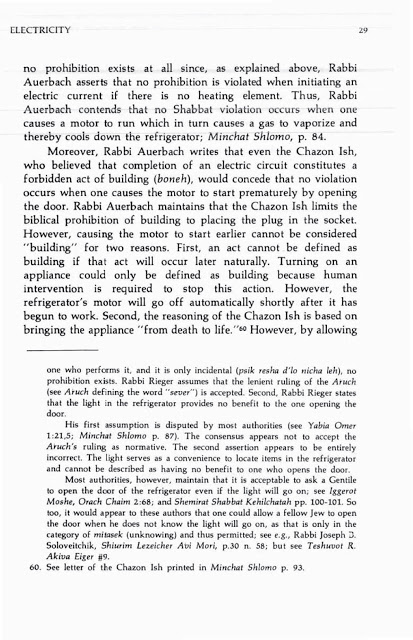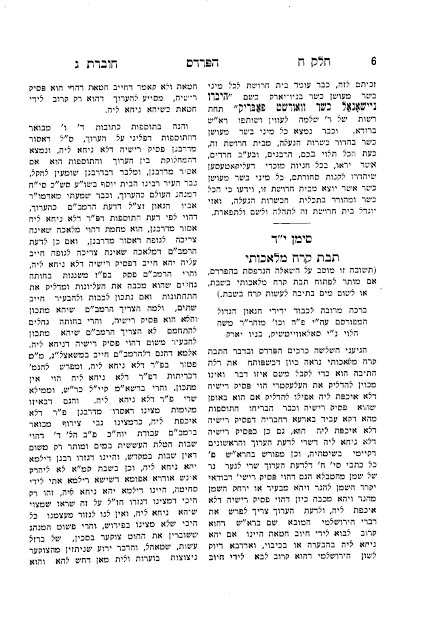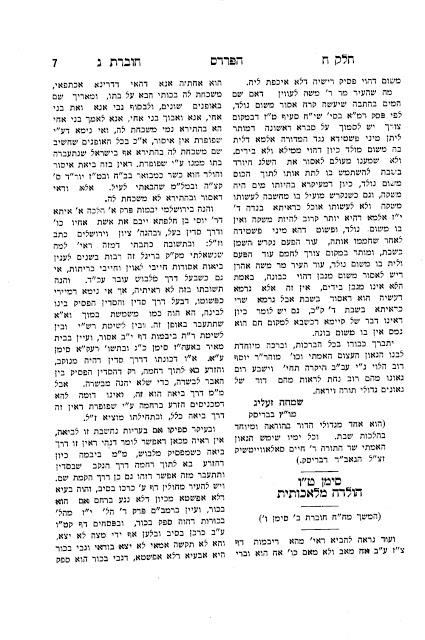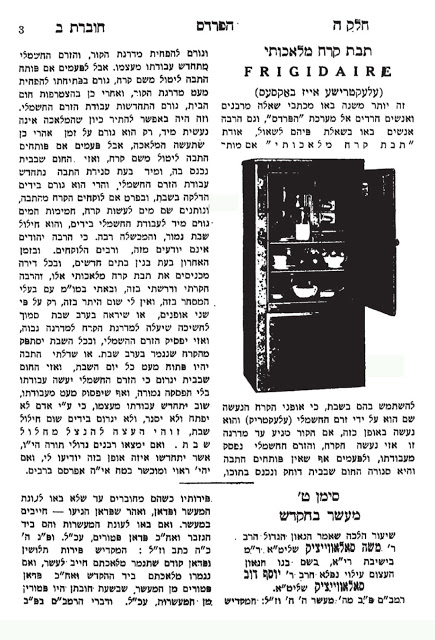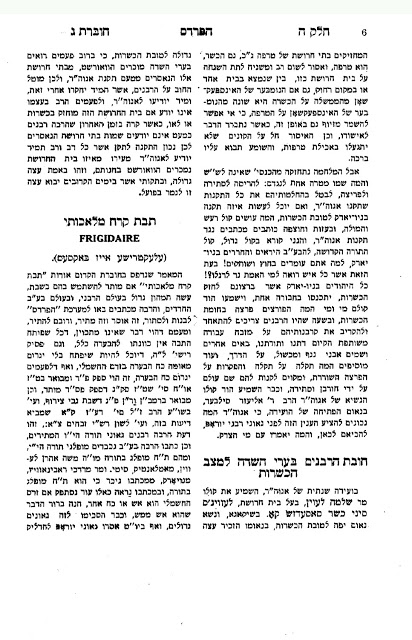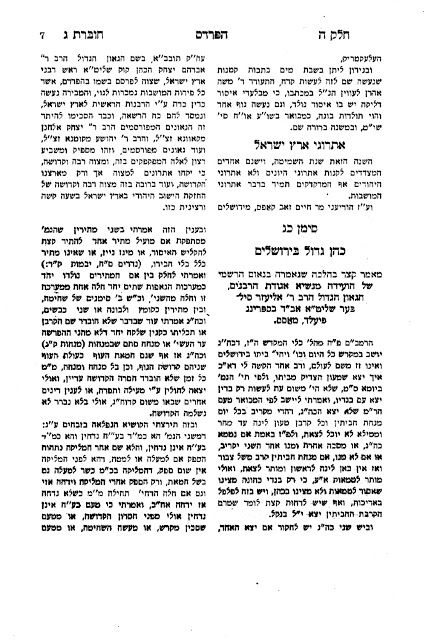עקידת יצחק בראי הלכה
מאת יחיאל גולדהבר
There have been numerous articles and even entire books about the Akedah. Here is a new collection of material on the subject from Rabbi Yechiel Goldhaber.
הניצוץ
הפנימי המתנצנץ ובוער בלב כל נפש ישראל פנימה, ייסודו ומקורו מאותו עמוד לבת אש
קודש שיקד והאיר את העולם ואת העולמות כולם, נשגב ונעלם מהשגת אנוש, טמיר ומכוסה
אף משרפי מעלה ומלאכי מרום. רשפיה רשפי אש, מעמד העקידה הקדושה שעקד אברהם את יצחק
בנו יחידו לה’.
מעמד זה
כל כולו “לב” – אהבה ויראה, צמאון ודביקות עד כלות הנפש. אך על כל שגבה
ורוממותה, עם זאת, חכמי הדורות לא מנעו עצמם להעביר ענין זה בכלי
ה”מוח”, ללמוד ולהבין, לבחנה בכור ההלכה ובמאזני המשפט, על פרטיה
ודקדוקיה.
יש
להקדים ולומר לגבי גדרו של העלאת יצחק, חז”ל מסרו היה לו דין של קרבן. יסוד
הדברים מעוגנים בדברי המדרש (בר”ר נה, ז): אמר אברהם לפניו, רבון העולמים יש
קרבן בלא כהן?, א”ל הקב”ה, כבר מיניתך שתהא כהן[1]. וכן
דייק החת”ס (יו”ד רלד) בדברי הרמב”ם פ”ב מבית הבחירה
ה”ב, (המתאר את השתלשלות הקרבת הקרבנות בהר המוריה), שאברהם קידש את מקום
המקדש בקדושת המקדש בשעת העקידה.
אם כנים
הם הדברים, לכאורה יש לנו להתייחס להשתלשלות פרטי העקידה שיהיו תואמים הלכות
קרבנות.
תמה
הרמב”ן: מדוע ראה אברהם אבינו להביא עמו עצים מביתו[2], כמו
שנאמר: “ויבקע עצי עולה ויקם וילך אל המקום”.
אלא יש
לומר, כי מרוב חשק וזריזות לקיום המצוה חש אברהם אבינו פן לא ימצא עצים במקום
ההוא, לכן בחר לטול עמו את העצים מבית ולשאת אותם במשך שלושה ימים, ובלבד שלא יהיו
כל עיכוב ומניעה לקיום הציווי.
זאת
ועוד, אף שמן הסתם ימצא שם עצים, מכל מקום חשש אברהם אבינו “לדין תורה”
(מסכת מדות פ”ב מ”ה) עץ שנמצאה בו תולעת פסול לקרבן. ולפיכך “ויבקע
עצי עולה”[3], בדוקים
ומהודרים, ואותם נשא עמו אל מקום העקידה.
היוצא
לנו מדברי הרמב”ן שאפשר להפיק מכל פרט ופרט של מהלך העקידה שיהא תואם עם כללי
התורה
[4]. ולכן יצאתי לגני ללקוט שושנים
וורדים, מספרים נדירים וגם מפורסמים, כדי להראות את יופיה של “תורת
העקידה”
*
‘אין
מכבדים בדרכים’
וישכם
אברהם בבקר ויחבש את חמרו ויקח את שני נעריו אתו ואת יצחק בנו, ויבקע עצי עלה ויקם
וילך אל המקום אשר אמר לו אלקים (כב, ג)
בפסוקים
הבאים חוזר על עצמו פעמיים הביטוי “וילכו שניהם יחדיו”, בפסוק ו’ אחרי
תיאור נשיאת העץ והמאכלת, וכן בפסוק ח’ בעת בתגובת אברהם ליצחק שה’ יראה את השה.
“מקשים
העולם” פותח רבי יעקב אב”ד פלאצק את דבריו: למה חוזרת התורה פעם
אחרי פעם בביטוי זה, הוא מותיב והוא מפרק:
“בהקדם
מאמרם (יומא לז ע”א): שלושה שהיו מהלכים בדרך, הרב באמצע, גדול בימינו וקטן
בשמאלו. המהלך כנגד רבו –היינו לצידו- הרי זה בור, ופירש רש”י (עיין ברכות דף
כז ע”ב) “מראה כאילו הם שווים”.
והנה,
שנינו (ברכות דף מו ע”ב): אין מכבדים לא בדרכים ולא בגשרים, והקשו שם תוס’
(ד”ה אין) הרי לפי הדין שאין מכבדים בדרכים, מדוע יש להקפיד על אופן ההליכה
של תלמיד עם רבו, ואם כן מדוע יש כל המהלך כנגד רבו הרי זה בור.
ויש
מיישבים, שכל הדין ש”אין מכבדים בדרכים” לא נאמר אלא במקום סכנה, שאז
אין חיוב על האדם לכבד את מי שמחוייב בכבודו בדרך כלל. ועוד יש לומר, שדין זה של
“אין מכבדים בדרכים” הוא דווקא כשהולך לדבר מצווה, שאז הליכתו בזריזות
לקיים מצווה.
והנה,
ידוע מה שמסרו חז”ל (ילקוט שמעוני, וירא פס’ צט; בראשית רבתי, על אתר):
“הלך השטן ונעשה לפניהם כנהר גדול שלא יוכלו לעבור. אמר אברהם, אם יורדים
הנערים מתיירא אני שמא יטבעו. ירד עמדו להם המים עד צוואריהם. תלה אברהם את עיניו
לשמים, אמר: רבון העולמים! באו מים עד נפש”.
לפי זה
יש לומר, כיון שהיו במקום סכנה, חל דין “אין מכבדים בדרכים”. לכן מדויק
לשון הפסוק “וילכו שניהם יחדיו“, היינו שהיה יצחק מהלך כנגד אביו
ולא כיבדו לילך לפניו.
לאחר
מכן, כששאל יצחק את אברהם “ואיה השה לעולה”, והשיבו “אלקים יראה לו
השה לעולה בני” שוב הזדרז יצחק כדין ההולך לדבר מצוה. ועל כן שוב נאמר “וילכו שניהם יחדיו” שלא היה
צריך לנהוג בו כבוד
[5].
*
ויקח
אברהם את עצי העלה וישם על יצחק בנו ויקח בידו את האש ואת המאכלת וילכו שניהם
יחדיו[6] (כב,
ז)
רבים
דייקו שהנחת העצים על גבי יצחק מוכיח לכאורה שיצחק עדיין לא היה מקודש, שאם כן,
הלא מסקנת הסוגיא בפסחים דף סו שאסור לתחוב סכין ע”ג קרבן שהרי הוא מועל
בהקדש[7], ולכך
מעלה
רבי יהושע העשיל אב”ד קראקא [שנד? – קראקא, תכ”ד], רבו של
הש”ך והב”ש, שיש קושי בנשיאת העצים על יצחק; לדעתו מיושב הדק היטיב
הדו-שיח של אברהם ויצחק. יצחק שאלו ‘הנה האש והעצים איה השה לעולה’, ביאור תמיהתו
הוא בכך ששאל ממ”נ, אם הנחת עלי את העצים מוכח שאני לא הקרבן, א”כ “איה
השה”? עד כאן מדברי הרב, ותלמידו רבי אליעזר טרילינגר [כיהן כרב בכמה ערים
במורביה] הוסיף על משקל זה את תשובת אברהם ש’אלהים יראה’, הוראת שעה היתה אצלי[8].
ואילו רבים המשיכו את הווארט: שאברהם ענה לו באותו מטבע: אלהים יראה לו השה, ואם
לאו לעולה בני, עד השתא עדיין לא הקדשתיך, ועדיין מותר לעבוד בך
[9].
המלבי”ם
כיוון לדבריו, והסיף פרפרת נאה לצידו: יצחק הקשה לאביו, אם כך יוצא שתקדיש אותי
ביו”ט! וביו”ט הרי אסור להקדיש? ועל כך השיבו אברהם, כי שונה הדין בחובה
שקבעו להם זמן שמותר להקדיש. לכן אמר בלשון “אלוקים יראה”, ואין אני
המקדיש.
רבי יוסף
ראזין מדווינסק נוקט בפשטות שיצחק כבר היה מקודש
[10], אלא הוא מדקדק:
מדוע את העצים
הניח אברהם על גבי יצחק, ואילו את המאכלת נטל בידו?
הוא
מיישבו בהברקה: בהקדם סוגיית הנחת סכין על גבי הקרבן (פסחים דף סו רע”ב)
ששיטת הבבלי הוא שלאחר שהוקדש הקרבן אסור להניח עליו הסכין, משום לאו ד’לא תעבוד
בבכור’. מאידך שיטת הירושלמי (שם פ”ו ה”א, הובא בתוס’ על אתר) שמותר,
וטעמם: משום שכל עבודה שהיא לצורך קדשים אינה עבודה[11].
והנה
להלכה אין זה לעיכובא שתהא השחיטה בכלי שרת דווקא[12], שוב
אם כן אין זה “צורך קדשים” ליקח מאכלת מביתו, לכן את המאכלת לא יכול היה
אברהם להניח על גבי הקרבן (יצחק)[13].
לעומת זאת, את העצים הכשיר אברהם, שיפו ועשה מהם גזירים, וכמו שנאמר “ויבקע
עצי עולה”, והרי הם “קדושים בקדושת הגוף”[14], לכן
מותר היה להניחם על גבי הקרבן
[15].
יישוב
מקורי העלה האדר”ת, לפי דבריהם במסכת בכורות דף ט ע”ב אין איסור ‘עבודה’
באדם שהוא קדוש, כל שכן ביצחק אין איסור להשתמש בו[16].
*
“נשיאת
העצים ביו”ט”
איתא
במדרשים (פדר”א פ’ לב[17])
שהעקידה היתה ביוה”כ[18], לפי
זה תמה רבי מאיר לייביש בעל המלבי”ם: איך נשא יצחק את האש והעצים, הלא
עברו על איסור הוצאה?
“ויש
לומר” ממשיך המלבי”ם בהקדם מאמרם (שבת דף ו ע”ב) שבזמן שאין ישראל
שרויים במדבר הרי המדבר דינו רק ככרמלית.
אך קשה,
מפני מה לא לקח עמו החמור, ואף לסובר שהטעם שאין רוכבים על החמור הוא גזירת שמא
יחתוך זמורה, הרי כבר חידשו הפוסקים (מג”א סי’ שכב) שבשניים אין מקום לחשוש,
וכדין הקורא לאור הנר. ומה עוד שהמג”א הוסיף שכל זה הוא במקום מצוה, הרי גם
כאן הוי מקום מצוה.
ואין
לומר שיש מקום לחשוש ‘שמא יצא חוץ לתחום’, ויש לחשוש למ”ד תחומין דאורייתא
(ראה ביצה לו)[19], שהרי נאמר
‘וירא את המקום מרחוק’, והוא שיעור מיל כפי שדרשו על הפסוק (יהושע ג, ד) ‘רק רחוק
יהיה ביניכם ובינו’ (ראה רש”י לשמות לג, ז). אמנם לפי הירושלמי המובא
ברא”ש שיש איסור שביתת בהמתו, ניחא.
ויש
לתרץ, שזהו שכתבה תורה ‘וילכו שניהם יחדיו’, היינו שלא עמדו לפוש בינתיים, ואם כן
לא היתה הנחה ולא עקירה, וכאשר הגיעו זרקו מידם כלאחר ידו, כהלכה
[20].
*
ויאמר
אברהם אל נעריו שבו-לכם פה עם החמור ואני והנער נלכה עד כה (כב, ה)
גם אל
ציווי שהיית הנערים הסמיך רבי יהונתן אייבשיץ למאמרם שחל ביוה”כ. ולכן חל
עליהם איסור יציאה חוץ לתחום: “אבל אברהם ויצחק הלכו ע”י קפיצת הדרך,
כאמרם (בר”ר מג, ג) פסיעות של אברהם אבינו ג’ מילין, ופירש האר”י
ז”ל [שער מאמרי רז”ל, עמ’ מז] על-ידי קפיצת הדרך, לכן יכולים היו ללכת
גם ביו”ט”[21].
לכאורה צ”ב, מה לי שקפצה לו הדרך, הלא במציאות עבר את תחום ולדברי החת”ס בספרו תורת משה ניחא האי
תמיה, וכה כתה: “נ”ל משום שהיה ביוה”כ, ע”כ אברהם ויצחק
שנצטוו על ההליכה היה דוחה תחומים והלך אלפים ממקום ההוא, והנערים לא שמרו
כמ”ש הראשונים שהנפש אשר עשו יצאו מכלל ב”נ להקל לשמור שבת, ואברהם מצווה
על שביתת בהמתו, ע”כ ‘שבו לכם פה עם החמור’ “[22].
*
ויאמר
הנה האש והעצים ואיה השה לעלה
האם היה
חובת בקור ליצחק
הרי
ההלכה היא שקרבן תמיד צריך ביקור (רמב”ם תמידין ומוספין פ”א ה”ט), והיו שהעלו שליצחק היה דין של קרבן
תמיד[23].
ואמנם כל הדין הוא כדי שלא יהא בו מום, ואצל בני נח אשר אין פוסל בהם מום, רק
מחוסר אבר פוסל (ע”ז דף ה ע”ב), א”כ לכאורה לא היה צריך ביקור.
אלא
שלגבי אברהם אבינו שיצא מכלל בני נח, ולפי ההו”א של יצחק שכוונת אביו לשחוט
שה, אם כן היה טעון ביקור. ואם תמצא לומר שלכאורה כשר בעל מום, וכמבואר בזבחים
(קטו ע”ב) שעד הקמת המשכן כשר בעל מום אפילו בישראל, אבל כאן היה לו דין
מזבח, וכיון שהיה מזבח בעי ביקור כדיני מזבח. עומד על כך רבי מאיר שמחה הכהן
מדווינסק –פארה של לטביה
והוא
מבארו באופן נפלא: דין שני גזרי עצים ואש קדוש נאמר רק בהקרב על גבי המזבח, ולא
בהקרב על במה (מנחות כב). וזהו טענת יצחק “הנה האש והעצים” – אם כן מוכח
שאתה הולך להקריב קרבן תמיד במזבח. ואם כן “איה השה לעולה” – הרי
קרבן תמיד במזבח טעון ביקור, ואיה הוא?
על כך ענהו אברהם: ‘אלוקים יראה השה’, היינו שהוא
כבר מבוקר[24].
אמר
יחיאל: הפלא הוא שכיוון את דבריו מילה במילה לספר הנפלא ‘צפנת פענח’ לרבי יוסף
מטראני [צפת, שכ”ט – קושטא, שצ”ט] -פארה של צפת, בנו הגדול של
המבי”ט, פ’ וירא ראש דרוש ג[25];
ולאחריו פירש כן רבי חיים אבולעפיה – פארה של טבריה שדרש את שאלתו של יצחק ‘איה
השה’ שהרי יש לבודקו לפני השחיטה, ועל כך ענה לו אברהם : “אלהים יראה לו השה –
שצריך בקור ד’ ימים, אם יראני השי”ת שה מבוקר שהוא בקרו – נקרבנו, ואם לא –
די היום בעולת בני תחת עולת התמיד”[26],
והוסיף שכן מפורש בפיוט ‘עת שערי רצון להפתח’ לר”ה[27],
נאמר: “שחר השכים להלוך בבוקר, ושני נעריו ממתי השקר, יום השלישי נגעו אל
חקר…הלכו שניהם לעשות במלאכה. ויענה יצחק לאביו ככה, אבי ראה אש ועצי מערכה, איה
אדוני שה אשר כהלכה? האת ביום זה דתך שוכח…”, הרי לנו שהשה צריך להיות
מבוקר כדת[28].
יוצא מן
הכלל הוא רבי אברהם פאלאג’י, המעלה שבכוונה ציווה לו ה’ יום לפני יציאתו מהבית,
והדרך לקחו ג’ ימים, הרי ביחד היה לו ד’ ימים לבקר, ואכן בקרו[29].
*
בעלי
חיים נדחין בחסרון מזבח
בסוגיית
פסול הקרב התלוי במזבח נחלקו במסכת זבחים (דף נט ע”א) רב ורבי יוחנן אם נפגם
המזבח לאחר שהקדיש הבהמה ועדיין לא שחטוה. דעת רבי יוחנן לפסול, ונימוקו עמו: כל
דבר שהיה בתחילה ראוי למזבח ואח”כ נדחה, הרי הוא דחוי מן המזבח לעולם. ואילו
דעת רב להכשיר, ולשיטתו: אין תורת דיחוי בקדשים אלא כשהיה הדיחוי לאחר שחיטתם.
יוצא, שלדעת רבי יוחנן כל הקדשים שהוקדשו בזמן שלא היה מזבח, ואח”כ נבנה
המזבח – פסולים. מעלה רבי חיים אבולעפיה (השני) מהלך מפולפל:
יצחק סבר
כרבי יוחנן שבע”ח נדחין, ודחוי מעיקרא הוי דחוי, לכן פנה לאברהם עם תמיהה:
איה השה “להקדישו” לעולה אחר בנין המזבח, שהרי אני נפסלתי שהרי הקדשת
אותי לפני בניית המזבח. השיבו אברהם: ‘אלהים יראה לו השה’, בכהאי גוונא שהמזבח
אינו בנוי מותר משני טעמים. א. דחוי מעיקרא אינו דחוי[30]. ב.
הרי הרמב”ם מכריע כדעת רב שבע”ח אינם נדחים[31].
רבי אהרן
שמואל קיידאנובר בעל ‘ברכת הזבח'[32] העלה
דרך דומה: יצחק ידע שכוונת אברהם להקריבו לעולה על המזבח. מבואר בחז”ל שאותו
המזבח היה אותו מזבח שעליו הקריב אדם הראשון את קרבנו, א”כ הרי נימוח
אח”כ עם מי המבול. כעת שיצחק ראה שעל ההר אין שם מזבח, והרי אביו הקדישו קודם
בניית מזבח חדש, הרי הקדישו קודם מזבח, כמפורש בקרא (פסוק ט) ויבן שם מזבח, לכן
שאלת יצחק מובנת כמין חומר: “איה השה”? הרי אני פסול לקרבן מטעם דחוי,
לכן על כורחך עליך להקדיש שה במקומי. על פי זה מדוייק תגובת אברהם: אלקים יראה השה
לעולה, אכן כדבריך, אבנה את המזבח ורק אח”כ אקדיש שה, ובאם לאו אז אקדיש
אותך, שהרי באמת עדיין לא הקדשתי אותך[33].
*
מדוע
הצניע אברהם את המאכלת.
כאשר הלך
אברהם עם יצחק לעוקדו נאמר ‘ויקח אברהם את עצי העולה… וייקח בידו את האש ואת
המאכלת וילכו שניהם יחדיו’. אך כאשר תמה יצחק לפשר הדבר, שאל ‘הנה האש והעצים ואיה
השה לעולה’. ותמוה, מדוע לא הזכיר גם את ה”מאכלת”[34]?
עמד על
כך מהרי”ל דיסקין אב”ד בריסק, והוא מיישבו על פי המובא בפתחי
תשובה (סי’ לו ס”ק ט”ז) שאין להראות הבהמה או העוף כיצד שוחטים משום צער
בעלי-חיים, או משום חשש צימוק הריאה, והוא הדין סכין של שחיטה.
ולפי זה
יש לומר, שבאדם אשר הוא בר-דעת ודאי שיש לחוש שבראותו הסכין שמיועד לשחטו, יפחד
ויבעת ומתוך כך תצטמק הריאה שלו.
לכן
הטמין אברהם את המאכלת בפני יצחק לגמרי כדי שלא ייטרף וייפסל מקרבן. ולכן יצחק לא
הזכיר בשאלתו את המאכלת. ואסמכתא לכך מדברי המדרש[35]
שיצחק אמר לאביו: ‘אסרוני בידי וברגלי שהנפש חצופה היא שלא תראה המאכלת ואפסל מן
הקרבן’, ופירש הרב מבריסק שהכוונה שהפחד יגרום שיצטמק הראיה ויטרף[36] .
המעניין
שכיוון לדבריו רבי צבי הירש פרבר [סלבודקה, תרל”ט – לונדון, תשכ”ז]
מחשובי רבני לונדון, והוסיף אסמכתה מלשון הסליחה (יום ה’ לעשי”ת):
“מאכלת שנונה מרוטה לָטֶבַח, נְדָנָהּ נתן מלהבעיתו בּאֶבַח”[37].
אולם
לדבריהם צ”ב למה יצחק לא שאל גם על הסכין[38]!
*
ביום
השלישי וישא אברהם את עיניו… ויאמר אברהם אל נעריו שבו לכם פה עם החמור ואני
והנער נלכה…
רבה של
זאמושט –רבי יצחק הויכגלרנטר חידש שאיסור רכיבה בשבת אסור גם בשנים, מה שאין-כן
למ”ד שאסור גם ביו”ט, יש מקום להתיר רכיבה בשנים לצורך מצוה. לאור חידוש
זה ממשיך לבאר בטוב טעם למה אברהם ירד מן החמור ביום השלישי והלך רגלי.
בהקדם
המבואר ביומא (כח ע”ב) שאברהם אבינו קיים גם במצוות דרבנן, והרי אם העקידה
היתה בשבת, היה יכול אברהם לרכוב יחד עם יצחק, אולם לפי הדעה שהעקידה היתה
ביוה”כ, מדוקדק שביום השלישי לא השתמשו ברכיבה על החמור, אלא הלכו רגלי, והלא
אין משתמשים בבעלי חיים ביו”ט, ולא מהני רכיבה שנים[39].
*
וישלח
אברהם את ידו ויקח את המאכלת לשחט את בנו.
פסול
אונן
לכאורה
צריך ביאור, מה היתה כוונתו של אברהם בשחיטת בנו, הלא ברגע שהוא שוחטו נעשה אונן,
והוא פסול להמשיך את העבודה.
קושיא זו
הקשה לראשונה (?) רבי דוד סג”ל בעל ‘הט”ז’. והוא מיישבו בהקדם
ביאור בדברי מדרש רבה.
במדרש
(נה, ז) מתואר דין ודברים שניהל אברהם עם כביכול: “אמר אברהם לפני
הקב”ה: רבון העולמים! וכי יש קרבן בלא כהן, אמר לו הקב”ה: כבר מניתיך
שתהא כהן, הה”ד (תהלים קי, ד) ‘אתה כהן לעולם’.
עמד
רבינו הט”ז על דבריהם אלו: מה זו הקושיא ‘וכי יש קרבן ללא כהן’, ולמה לא יכול
אברהם להיות כהן. ועוד קשה, מאי ‘כבר מניתיך שתהא כהן’, היכן מינה אותו הקב”ה
להיות כהן.
הוא
מותיב וגם מפרק, שביאור הדברים הוא כך: ‘וכי יש קרבן בלא כהן’, הרי מיד עם מיתת
יצחק נעשה אונן ואסור להקריב (זבחים טז ע”א), ואם כן יהיה קרבן ללא כהן.
והתשובה היתה: כבר מניתיך שתהא כהן, היינו כהן גדול, וכהן גדול מותר להקריב
באנינות (יומא יב ע”ב). והראיה שנעשה לכהן גדול דייקא, מדברי המדרש
(שם): שאמר אברהם ‘הנני’, הנני לכהונה הנני למלכות, זכה לכהונה וזכה למלכות. ודייק
הט”ז שהכוונה לכהונה גדולה, מלשון המקרא (תהלים קי, ד) ‘אתה כהן לעולם’,
היינו אתה כהן לעולם אפילו בעת אנינות[40].
לאור
האמור מדויק הטיב לשון המקרא[41]
‘ויאמר יצחק אל אברהם אביו, ויאמר אבי, ויאמר הנני בני’, מהו האריכות בפסוק, ומהו
כפל הדברים?
אולם לפי
האמור עד כאן, הרי הוא כפתור ופרח: יצחק טוען לאברהם, שכל הטענה שיש לי כלפיך היא,
בכך שאתה אבי, ואם תשחט אותי תהא ‘אונן’, שהרי אני רואה “האש והעצים”,
אם כן בדעתך להקריב קרבן. אך כיון ש”איה השה לעולה”, שה לעולה אין, הרי
שבדעתך שאני אהיה הקרבן, אולם איך תוכל להעלותי לקרבן כשתיכף בעת השחיטה אתה נעשה
‘אונן'[42].
בן דורו
–רבי אברהם אבלי גומבינר מקאליש בעל ‘מגן אברהם’ כיוון לדבריו. על דברי
המדרש (פרקי דר”א, פ’ לא) שדימה את אברהם אבינו לכה”ג שהגיש מנחה
ונסכים, כתב: והא דאמר כהן גדול, משום שקשה כיון שיקריב את יצחק יהיה אונן,
וא”כ יאסר להקריב אח”כ מנחה ונסכים. לזה אמר ‘ככהן גדול’, שהרי
קיי”ל כהן גדול מקריב אונן”[43].
לגאון
הראגיצ’ובער יש מהלך נפלא ביותר.
לדעתו
(על פי הפסיקתא) לאברהם היה דין של כהן הדיוט, ולכאורה האיך היה יכול אברהם ראוי
להמשיך את העבודה? הלא גם בהקרבה בבמה מסתפק הגמרא (זבחים טז ע”א) האם מותרת
באונן.
אלא על
פי מה ששנינו ביומא דף יג: היה עומד ומקריב ושמע שמת לו מת, מניח העבודה ויוצא,
דברי רבי יהודה. רבי יוסי אומר, יגמור. פירש רש”י: שהיינו לגבי כהן הדיוט[44].
והנה השחיטה אינה “עבודה” וממילא אינה “התחלה”. לכן דקדק
אברהם לערוך את העצים, שזהו “סידור גזרי המערכה”, שהיא
“עבודה” ואסורה לזר. וכיון שכן – “כיון שהתחיל, גומר”.
מהלך
ייחודי דרך לו רבי דוד לוריא מביחוב, לדעתו אינו ניתן להחיל דיני אנינות על מיתה
שנעשתה ע”י ציווי השי”ת. הוא משיג על דברי הזית רענן (שצויין לעיל):
“ואינו נכון… בעיקר הדבר, אם שייך בכאן אנינות בדבר צ”ע, כיון שאבילות
ודאי לא היה כאן, כמו בהרוגי סנהדרין (מו ע”ב) שאין קרוביהם מתאבלים עליהם,
כל שכן כאן שצוהו ה’ על זה”. בהמשך דבריו הוא מעלה שחידוש זה אינו מוסכם בכל
הראשונים.
רד”ל
מסיים בהערה ע”ד הזית רענן שיישב היות והיה לו דין כה”ג לכן לא חל עליו
דיני אנינות; מוסיף עליו רד”ל, לפי דבריהם תוסבר השיטה שהעקידה היתה
ביוה”כ, שרק כה”ג עובד את עבודת היום; אולם מסיים ש”באמת אין דבר
זה מוסכם שהעקידה היה ביוה”כ, כי בויק”ר משמע שהיה בחודש תשרי
ובשמו”ר אמרו שהיה בפסח”.[45]
רבי
אברהם פאלאג’י יישב את הקושיה בצורה פשוטה ביותר: זיל בתר טעמא, הלא טעם פטור אונן
מעבודה הוא, שמוטל עליו לקוברו, ואילו כאן מוטל עליו גמר עבודתו, וגימור העבודה
היא השריפה, והשרפה היא במקום קבורה[46]
אמר
יחיאל: תמיהני על כל הני אשלי רברבא ובפרט על הרד”ל, הלא בחג ויוה”כ לא
חלים דיני אנינות (יו”ד שמא, א), וזהו הטעם שכה”ג מותר לעבוד באנינות,
שהרי “כח השנה כרגל אצלו”, וע”כ נפל כל הקושי.
*
‘ויאמר
אל תשלח ידך אל הנער ואל תעש לו מאומה’ (כב, יב) חכמינו (ב”ר נו) דרשו את כפל
הלשון: שאברהם רצה לכל הפחות להוציא ממנו כמה טיפות דם, ועל כך ציווה לו
הקב”ה ‘אל תעש לו מאומה’.
החת”ס
עומד על כך למה אברהם עשה חבורה על יצחק והוציא קצת דם, כן מהיכן למד שיש לשחוט את
האיל לעולה?
הוא
מיישב בכך: “נראה שאברהם אבינו לא רצה לקדש המקום לבית עולמים עד שהקריב בו
שום קרבן, כיוון שנתקדש המקום ואינו מקריב קרבן, עובר על לאו ‘ולא יראו פני ריקם’,
לכן רצה לעשות קצת חבורה ביצחק ולהוציא ממנו קצת דם כדי שלא תהיה ביאה ריקנית.
וכשאמר לו הקב”ה ‘אל תעש לו מאומה’ הראה לו איל והקריבו עולת ראיה, אז אמר
אשר יאמר היום ‘בהר ה’ יראה’ “[47].
ברעיון זה קדמו רבי דוד פארדו [תע”ח-תקנ”ב]: “אל תשלח… והויא ליה
ביאה ריקית שהוא היה יודע ששם מקום בה”מ, הלכך אוציא ממנו מעט דם, שמקצת נפש
ככל הנפש”[48].
*
“עולה
שעלתה חיה על המזבח – תרד”
שנינו
במשנה (זבחים פד ע”א): “עולה [והוא הדין כל קרבן] שעלתה חיה לראש המזבח
תרד”, מבארת הגמרא שש להורידה משם כדי לשחוט, ולאחר השלמה עבודתה למטה, יש
להעלות את נתחיה להקטרה. אם כן תמוה, כיצד העלה אברהם את יצחק על גבי המזבח בעודו
חי?
לעיין שמן
המאור פ’ יתרו, שירת שמואל, סי’ סב
רבי
יהודה ב”ר עמרם דיוואן -מחכמי ירושלים[49],
כותב שכל ימיו התקשה בשאלה זו. ואם תאמר שהעלאתו היתה על פי אמירת השי”ת, הרי
לא מצינו שכך אמר לו ה’, והיה לו לאברהם
לעשות כדין עולה למטה ולהעלותו אח”כ כשאר עולות. ולא מצא ישוב לענין[50].
אולם מצאנו שרבים וגם שלמים נשאו ונתנו בקושיא זו.
הראשון
שדן בזה הוא רבי יוסף מטראני שזכה לנשק את ידיו של הב”י ולהתברך ממנו[51],
בדרשותיו מחדש מהרי”ט שיצחק התקדש רק עם העלתו ע”ג המזבח, וקדושה זו
קידשה אותו לתמיד. מהרי”ט מדייק את לשון המקרא: ‘והעלהו שם על אחד ההרים’,
לכאורה נכון היה לומר על אחד ההרים, העלהו שם, אלא דייק אברהם שמטרת עלייתו היא
לקדשו: “ולכך לא שחטו למטה והעלהו איברים כדין העולה”. ואפשר, ממשיך
מהרי”ט ומחדש: “שלא נאמר שחיטה למטה אלא בעזרה שהוא מקודש או בפנים מן
הקלעים, אבל מקום שלא נתקדש, צריך להעלותו על המזבח שנתקדש בבניינו, בין כך ובין
כך העלתו קדשתו, ולא צוה הקב”ה לשוחטו אלא להעלותו ולקדשו”[52]
השני
שהעלה קושי זה היה רבי חיים אבולעפיה (המוסמך)[53],
נכדו רבי חיים אבולעפיא[?- טבריה, תק”ד][54] הביא
את הקושי משמו[55], ומנסה
ליישבו בכמה אנפין: בשם [רבו[56]] רבי
משה גלאנטי (השני) [צפת, ש”פ – ירושלים, תמ”ט] הוא מביא: מאחר שהטעם
לפסול העלאת הקרבן חי מעל המזבח הוא ‘שמא ירביץ גללים’, “לא שייך האי טעמא
ביצחק שהלכו שניהם יחדיו הבן להזבח והאב לזבוח”[57].
ביאור דבריו הוא כנראה כך, למרות שטבעו של אדם להזדעזע מפחד הריגה ועלול להוציא
צואה[58], אבל
יצחק שהלך בכוונה להישחט, אין מקום לחשוש. תירוץ נוסף העלה הרב המג”ן:
“על פי מאמרם במדרש שהשטן רצה להטיל בו מום ולפוסלו, לכן רימה אותו אברהם בכך
שיחשוב שעדיין לא הגיע זמן השחיטה, ומוטב לעשות איסור זוטא שלא יפסל מכל וכל”
[59].
ורח”א
בעצמו מיישבו דין זה לא נאמר אלא רק בבית המקדש, שבו “המזבח” הוא
לעיכובא, אולם ב’במה’ אין דין מזבח, ועל כן אין דין זה מעכב. ואמנם כל מה שעושים
‘מזבח’ זהו רק כדי שיהא תשמישו נח, כמו שאמרו (זבחים קח), או שכאן היתה הוראת שעה
שיבנה מזבח בבמה.
לפי זה
באמת אין כל משמעות והבדל בין “על גבי המזבח” ל”על גבי קרקע”,
כי כל בנין המזבח אינו אלא רק כדי שיהא תשמישו נח, ואין כל מניעה להעלותו על המזבח
כשהוא חי.
ואף אם
נאמר שעל פי הדיבור בנה אברהם את המזבח, אם כן יש לומר שגם על פי הדיבור היתה
העלתו כשהוא חי[60].
רבי שלמה
אליעזר אלפאנדרי שכיהן כחכם-באשי בדמשק בשנים תרנ”ד-תרס”ח[61],
מיישב את קושיית רבי יהודה דיוואן: נראה שלא קשה, מלבד מה שקיי”ל כרבי יוסי
שטעמו עמו, ששחטה בראש המזבח יפשיט, שנאמר ‘וזבחת עליו את עולותיך’ מלמד שכל המזבח
כשר לשחיטת העולה (שם, נח ע”א), ודוקא לאחר מתן תורה שקבע הכתוב לעולה – צפון
הוא שאמרו לכתחילה ישחוט בצפון.
ועוד, כי
כשאמר לו הקב”ה ‘והעלהו שם לעולה על אחד הרים אשר אומר אליך’ הבין אברהם
שיעלהו וישחטהו שם. וכן מוכח מחז”ל (ב”ר נו, יב) שהתחיל אברהם תמה: אמרת
‘קח נא את בנך’, ועכשיו אתה אומר לי ‘אל תשלח ידך אל הנער’. אמר לו הקב”ה,
כשאמרתי לך ‘קח נא’ לא אמרתי ‘שחטהו’ אלא ‘והעלהו’, לשם חיבה אמרתי לך, אסיקתיה
וקיימת דברי ועתה אחתיניה וכו'[62].
לפי זה,
מה שהבין אברהם במאמר ה’ ‘והעלהו לי’ – שיעלה אותו לראש המזבח, יפה כיון, ורק מה
שהבין שגם ישחטהו, על זה אמר לו שאינו
נכון. את יישובו השני, כיוון הרב אלפאנדרי לבן מדינתו –רבי יצחק ברכה, מחשובי רבני
אר”ץ, ושעל דרשותיו בספרו ‘בירך יצחק’ העיד -בן דורו- החיד”א: שהם
“נחמדים”[63].
יישוב
ייחודי העלה החת”ס. בדרשתו לפרשת בא בשנת תקצ”ד חידש החת”ס ששאני
קרבן עולה שפושטים ממנה את עורה טרם ההקטרה משא”כ עור האדם כבשרו ורצה
להקטירו כולו, על כן נעקד ע”ג המזבח, והיא כולו קודש[64].
הנצי”ב מוואלוז’ין, כיוון לדברי החת”ס, לדידיה: הטעם שאין מעלים קרבן על
המזבח חי: “משום שאין עור הבהמה קרב, מה-שאין-כן עור האדם שהוא בשר ממש, טוב
יותר להעלותו חי”[65].
ומן
הצורך לציין לדבריהם ב’במדבר רבה’ (יז, ב) שם מסופר השתלשלות מעשה העקידה, ובין
הפרטים נמסר גם על כוונת אברהם להפשיט את עור בנו: “אמר אברהם, רבון
העולמים.. נטל האיל והפשיטו, ואמר כך: תהא רואה כאילו עורו של יצחק הפשטתי
לפניך”[66].
*
היכן
מקום שחיטת העולה – בצד המזבח או על גביו
הקשה
השפ”א: הרי מקום שחיטת העולה בבית המקדש היה בצד המזבח ולא על גבי המזבח.
וא”כ, כשהעלה אברהם את יצחק לעולה כפי שנצטווה: והעלהו שם לעולה, למה העלוהו:
על המזבח, וכמו שנאמר: וישם אותו על המזבח ממעל לעצים.
על הפסוק
“ושחט אותו על ירך המזבח צפונה לפני ה’ ” (ויקרא א, יא) דרשו חז”ל
(ויק”ר א, ה): שבעת שישראל מקריבים תמיד ע”ג המזבח וקוראים את המקרא הזה
זוכר הקב”ה עקידת יצחק. ובתנדב”א מובא: זוכר אילו של יצחק. ולכאורה, מה
ענין “אילו של יצחק” ל”צפון” דווקא. ועוד, במקום לומר “אילו
של יצחק” היה לו להזכיר “עקידת יצחק” גופא.
אב”ד
ירושלים -רבי צבי פסח פרנק מוסר ששמע מפי מהרי”ל דיסקין שכה פירש:
אכן
בזמנים קדומים היה נהוג להקריב את הקרבן ע”ג המזבח ממש ולא בצידו[67],
וכפי שנתפרש בכתוב בעקדה. אלא בעת שהראהו לאברהם את האיל המוכן וראוי לקרבן תחת
בנו, היה על אברהם להתיר עקידת בנו ולהורידו מע”ג המזבח ולהעלות תחתיו את
האיל. אולם לא כן נהג אברהם, משום שחשש וירא שמא יהא איזה פגם ופסול בהקרבת האיל,
ואז שוב יהא יצחק הקרבן. על כן השאיר אברהם את יצחק על המזבח כדי שיהא מוכן
וראוי להקרבה בכל עת., ואילו את האיל שחט בצד המזבח לצפונו.
לכן מאז,
בשעה שישראל מקריבים קרבן ושוחטים אותו לצד המזבח צפונה וקוראים מקרא זה, הרי זה
מזכיר את עקידת יצחק ומעורר את גודל האהבה ומסרות נפש של אברהם אבינו, שלרוב אהבתו
ורצונו לעשות את רצון ה’ השאיר את יצחק ע”ג המזבח שמא שוב יזדקק
להקריבו, וע”כ הקריב את האיל בצפון. נמצא שהשחיטה ב”צפון” מזכרת
ומעוררת ענין זה ואכן מטעם זה וזכר לדבר נקבע מכאן ואילך עולמית מקום שחיטת קדשי
קדשים בצד צפון[68].
*
בענין
זריקת הדם כבר עמד רבי אבי עזרי מרגליות דיין בקאליש [ת’ לערך, פלאצק – תע”ד,
צפת] ופירש את דברי המדרש (ילק”ש, וירא קא) שהמלאכים תמהו ‘ראו, יחיד שוחט
ויחיד נשחט’, שכוונתם שהלא אברהם עמד שם יחידי: “ואין איש לקבל דמו וא”כ
זאת שאלת המלאכים ‘יחיד שוחט’, וא”כ יהא דמו נשפך על הרצפה ואח”כ אספו,
פסול”[69]. וכן פירש
רבי חיים ב”ר יוסף חזן שתלונת יצחק היתה: “היות ואברהם יחיד אולי לא
יקבל הדם כתקונה.. ומה שצר לי הוא על דמי…”[70].
האם
אברהם לקח עמו את כל הנחוץ לקרבן
מזרק
לכאורה
אם אברהם לקח עמו את כל הנחוץ להקרבה, מדוע לא לקח ‘מזרק’, כלי לקבלת הדם, שהרי
לקבלת הדם צריכים כלי-שרת? תמיהה זו מעלה רבי פנחס מנחם יוסטמן אב”ד פילץ,
ונכדו של החידושי הרי”ם. לאחר פלפול בגדרו של מזבח זה של העקידה, הוא מעלה
שמא לא היה לו שמן למשחו, והוא ממשיך בטוב-טעם: הרי הציווי היה ‘והעלהו שם לעולה’
יש להניח שהבין שא”צ קבלת דם בכלי, שהרי זריקת הדם תתקיים מן הצואר אם המזבח,
ללא צורך בכלי[71].
מלח
אב”ד
פילץ עומד גם על אי אזכור של הבאת מלח מטעם אברהם, הלא חיוב להקריב על כל קרבן מעט
מלח[72].
וכדי ליישב זאת מעלה הוא שני מהלכים. שמא חיוב הקרבת מלח הוא דייקא על איברים
שמעלם ע”ג המזבח, א”נ שמא סבר כרבי (מנחות קו ע”ב) שעצים נקרא קרבן
וטעונים מלח והגשה[73],
ולכן קיים בביתו מצות מליחה על העצים[74].
עוד יש
להביא מן החדש, מחידושו של רבי מאיר שמחה מדווינסק, שבבמה אין צריך מלח[75],
ולכן לשיטה הסוברת שלעקידה דין במה, ניחא[76].
יין
על פרט
נוסף שחסר ברשימה מעלה הרבי מפילץ והוא היין לנסכו, ועל כך הוא מעלה: הלא
קיי”ל אדם מביא זבחו היום ונסכיו לאחר כמה ימים, ואולי חשש להאמין נעריו על
היין לנסך, ע”כ הוטב בעיניו שילך אח”כ לנסך[77].
*
מאימתי
חל שם “קרבן” ב”עולת יצחק”
על הפסוק
“אל תשלח ידך אל הנער” פרש”י: “אמר לו אברהם , א”כ לחנם
באתי לכאן, עשה בו חבלה ואוציא ממנו מעט דם”. אמר לו הקב”ה: אל תעש לו
מאומה, אל תעש בו מום”. ולכאורה, דברי אברהם תמוהים ואומרים דרשני.
הגרי”ז מבריסק ביאר, שדין ‘עולה’ שנאמר ביצחק חלוק שונה משאר דינים הנאמרים
בשאר קרבן עולה. בכל קרבנות עולה אין דיני “עבודה” בהם בהיותם בחיים,
וכל השם ‘קרבן’ אינו אלא מעת השחיטה, שהיא העבודה הראשונה, וממנה והלאה מתחילה
עבודת ההקרבה. לעומת זאת, אצל יצחק נאמר דין מיוחד של “עבודה” העלה –
“והעלהו שם לעולה”.
ומעתה
לאחר שהתבאר שבעולת יצחק נאמרו דיני עבודה גם קודם שחיטה, יתבארו ויובנו הדברים:
אמר אברהם אל ה’, הנה אף שנאמר שלא לשחוט את יצחק בנו, מכל מקום ניתן לקיים בו דין
זריקה גם מחיים. ואמנם בשאר קרבנות אין היכא תמצא כזה, משום שכל “עבודה”
מתחילה רק בשחיטה, אולם כאמור בעקידה היה דין שונה, והיה אברהם סבור שאף שהוא מנוע
כעת מלשחטו, אבל עדיין יוכל לקיים בו את עיקר הריצוי של קרבן, שהוא “זריקה”.
עד שהוצרך ה’ לצוותו “אל תעש לו מאומה”. אל תעש לו מום וחלה כלשהוא.
דרשו
בילקוט: אמר ה’ ליצחק, אתה עולה תמימה, מה עולה אם יוצאת חוץ לקלעים נפסלת, אף אם
תצא לחוץ תיפסל.
לכאורה,
הרי כל קרבן בעודו חי אף אם הוכנס לעזרה ואח”כ הוצא, אין בכך פסול, ‘יוצא’
וא”כ כבר התחילה בו עבודה בעודו בחיים, ויש עליו דין קרבן גמור, ולכן נפסל
ב”יוצא”.
*
‘נאחז
בסבך בקרניו’ -ניצוד ועומד
‘וישא
אברהם את עיניו והנה איל אחר נאחז בסבך בקרניו וילך אברהם ויקח את האיל והעלוהו
לעולה תחת בנו’.
ולכאורה,
לפי האמור בחז”ל היתה עקידה ביוה”כ, כיצד זה עבר אברהם על איסור צידה
ביוה”כ?
פירש
מהרי”ל דיסקין, כי לא כדי האיל “נאחד בסבך בקרניו”. הנה כי כן,
אילו לא היה האיל נאחז בסבך לא היה אברהם יכול לקחתו משום איסור צידה
ביוה”כ..
אולם
מאחר שנאחז בסבך בקרניו, הרי זה כניצוד ועמד, ואין כאן צידה ומותר (ע’ מסכת ביצה
כד.)
*
פנינה
יקרה שמעתי מפי הגאון רבי מאיר סולובייצ’יק שליט”א בשם אביו הגרי”ז
מבריסק שהסביר את רצונו של אברהם להוציא כמה טיפת דם מיצחק, שכמו שנתקיים אצל יצחק
הדין שהעלהו חי על גבי המזבח, שמא אפשר לקיים גם דין זריקת הדם בו בעודו חי, וללא
שחיטה, ולכן רצה לקיים גם מצות זריקת הדם.
*
שופר
מאילו של יצחק
בפרשת
יתרו על הפסוק ‘במשך היובל המה יעלו בהר’ (שמות יט, יג) פרש”י: “והוא
שופר של איל ושופר של אילו של יצחק היה”.
והוסיף
לפרש בעה”ט: “שגם לשם נזדמן לו שופר מאילו של יצחק, ובזכות זה השופר של
מתן תורה נפלה חומת יריחו”.
והקשה
הרמב”ן הלא איל זה היה עולה, והלא דין עולה לעלותו כליל – כול הקרניים
וטלפיים,.
ותירץ
מהרי”ל דיסקין, כי י”ל שהיה זה איל זקן והתקשו הקרניים הרבה מרוב זקנה,
ולכן לא שלטה בהן האש, ונתפקעו מעל המזבח. והלא דין הוא (רמב”ם הל’ מעשה
הקרבנות פ”י) כי העצמות והקרניים והטלפיים שנתפקעו מעל המזבח, שוב לא יעלו
*
לשון ר’
צבי מחכמי קלויז (בשינויים קטנים): “שאלני הרב המופלא בנגלה ונסתר המקובל
החסיד מוהר”ר אפרים זלמן מ”מ דק’ זאלקאווא, שמשמעות הפסוק שיצחק לא ראה
את הסכין, גם בפיוט משמע כך, וא”כ מהיכן החליט יצחק שיקריב שה לעולה, שמא
בדעת אברהם להביא ‘קרבן עצים’? והושבתי לו: שהרי למדים ‘קרבן עצים’ מהכתוב בפ’
מנחה ‘כי תקריב קרבן’ ודרשו חז”ל: קרבן להביא עצים, וכן הוא אומר ‘וגורלות
הפלנו על קרבן עצים (מנחות קו ע”ב). ובסוף זבחים אמרו ‘אין מנחה בבמה’, ואמרו
שם, אין עופות בבמה מ”ט זבח ולא מנחה ולא עופות. לפי זה גם קרבן לא הקריבו
בבמה, שלא עדיף מקרבן מנחה, ולרבי הוה קרבן עצים – מנחה (עיין דף כ ע”ב),
וא”כ לא היה יצחק מסופק כלל שיביא אברהם קרבן עצים, כי אינו קרב בבמה. והודה
הרב הנ”ל לדברי כי נראה נכון”[78].
ברכת
הגומל לאחר שניצל מהעקידה
כתב החיד”א
(מחז”ב או”ח סי’ ריט): “ארבע צריכים להודות וכו’. ראיתי לכתוב
ויכוח קצר מהרב המובהק כמהר”ר אליעזר נחום ז”ל עם עט”ר אבא מארי,
בחלומי והנה החכם השלם כמוה”ר יצחק זרחיה אזולאי לפני וראיתי שהלא דבר: יצחק
אבינו שניצול מהעקידה בירך ברכת הגומל דהא בא לידי סכנה, או לא?
“וכן
ד’ נכנסו לפרדס שהוא מקום סכנה, שהרי אחד מהם הציץ ומת ואחד הציץ ונפגע, א”כ
ר’ עקיבא שיצא בשלום, בירך ברכת הגומל או לא?
וכן
כה”ג שהי נכנס ליוה”כ לפני ולפנים, שהוא מקום סכנה, כמו שהיו אומרים לו
כשהיה נכנס למקום להבת שלהבת, ובצאתו בשלום מן הקודש היה מברך ברכת הגומל, או לא?
אלה
השאלות הייתי שואל בחלומי לאחינו הנזכר ולא השיב אותי דבר. לכן הוא יוציא משפטם
לאורה.
“ולענ”ד
נראה לחלק כי מעולם לא תקנו רבנן לברך ברכת הגומל שהיא ברכת הודאה, אלא דוקא בצרה
הבאה לאדם בעל כרחו ושלא מדעתו, ונעשה לו נס, אז חייב לברך, כי הני ארבעה [צריכים
להודות] כי “חיים” הם.
חולה, הירצה
אדם שיחלה, הרי פתע פתאום בעל כרחו בא החולי, כמעט שכב בדמשק ערס מתוך צרתו וכובד
חליו שב ורפא לו, חייב לברך.
יסורין,
ג”כ באים לאדם בע”כ וכשניצול מהם חייבוהו לברך, דאי לא תימא הכי,
ר”א בר”ש דבאורתא אמר (לייסורים) בואו אחי באו רעי, יתכן כי כל יום ויום
היה מברך, אין הדעת מקבלו, דמסורים היו בידו ומהיכי תיתי שיברך בכל יום. אבל
בקושטא ייסורים הבאים לאדם בע”כ וניצול מהם, הוא יברך.
אמנם
בדבר שהוא במאמר וציווי ה’ לעשותו, אז אפילו שלא יהיה בפרטות וביחיד, רק מימרא
דרחמנא לקדש שמו, אף שהקב”ה יעשה לו נס אינו מברך. וכן אני אומר כי יצחק
אבינו כיוון שהכל היה במאמרו וגזירתו יתברך, אף שניצול אינו חייב לברך.
אמר
יחיאל: לפי הסוברים שאכן פרחה נשמתו של יצחק, או הדיעה הקיצונית שאברהם שרפו, ורק
קם לתחיה, כפי שהארכנו בשולחננו בפרשת תש”ע, לכאורה היה צריך לברך ברוך מחיה
המתים[79].
*
[71] שפתי צדיק, ירושלים תשט”ז, עמ’ סא;
כיוון לדבריו הגאון רבי צבי רוטברג, ראש ישיבת ‘בית-מאיר’ (בני ברק), למיסבר קראי,
עמ’ ע.

